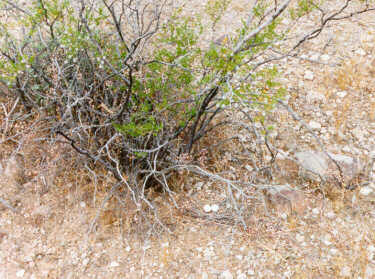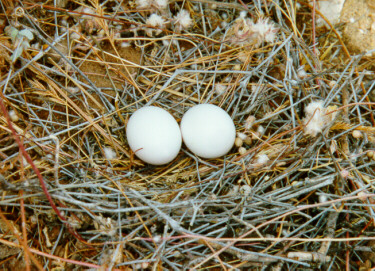Mourning Dove nest with eggs on completely flat ground.
Photos by Greg Clark, May 1998, South-Central Arizona
 What you see here is a Mourning Dove nest on the ground that is next to a Creosote bush. (The Creosote is the most abundant plant in the desert in Arizona, and may be the most abundant plant in the whole state). Located on a floodplain, the nest location does not have any significant vertical elevation above the surrounding floodplain. Because Creosote traps sediment at its base in a floodplain, the base of a Creosote IS slightly higher than the land a few inches away. However, in this case where the nest is located, there does not appear to be any elevation from sediment. The nest is otherwise unremarkable. It should be noted that most Mourning Dove nests we have observed have two eggs in them. The other photograph shows construction technique typical of dove nests, why change the method just because it is on flat ground? In fact, the amount of sticks and other material shown in the photograph are actually a little more (thicker layer) than some nests we have seen. Notice that it is possible to see the brown ground dirt color (between the sticks) almost right up to the edge of the eggs. We believe this is the only known documentation of flat-ground nesting for this species. Please let us know if you have seen other examples of Mourning Dove nesting on flat ground.
What you see here is a Mourning Dove nest on the ground that is next to a Creosote bush. (The Creosote is the most abundant plant in the desert in Arizona, and may be the most abundant plant in the whole state). Located on a floodplain, the nest location does not have any significant vertical elevation above the surrounding floodplain. Because Creosote traps sediment at its base in a floodplain, the base of a Creosote IS slightly higher than the land a few inches away. However, in this case where the nest is located, there does not appear to be any elevation from sediment. The nest is otherwise unremarkable. It should be noted that most Mourning Dove nests we have observed have two eggs in them. The other photograph shows construction technique typical of dove nests, why change the method just because it is on flat ground? In fact, the amount of sticks and other material shown in the photograph are actually a little more (thicker layer) than some nests we have seen. Notice that it is possible to see the brown ground dirt color (between the sticks) almost right up to the edge of the eggs. We believe this is the only known documentation of flat-ground nesting for this species. Please let us know if you have seen other examples of Mourning Dove nesting on flat ground.
6/16/99 - Update
Lin Baer is a columnist for the Tribune Newspaper. In her column, (480) Living, she recounted many interesting observations about Mourning Doves. Among these was a description of a Mourning Dove nest on the ground in northwestern Illinois. Although her lawn was steeply sloping, rather than dead flat, she did have a nest built into a hollow in the yard. This is somewhat novel because the birds used a below-ground level nest site.

Copyright Greg Clark, 1998
update 8/2012
mirror-pole.com home
 What you see here is a Mourning Dove nest on the ground that is next to a Creosote bush. (The Creosote is the most abundant plant in the desert in Arizona, and may be the most abundant plant in the whole state). Located on a floodplain, the nest location does not have any significant vertical elevation above the surrounding floodplain. Because Creosote traps sediment at its base in a floodplain, the base of a Creosote IS slightly higher than the land a few inches away. However, in this case where the nest is located, there does not appear to be any elevation from sediment. The nest is otherwise unremarkable. It should be noted that most Mourning Dove nests we have observed have two eggs in them. The other photograph shows construction technique typical of dove nests, why change the method just because it is on flat ground? In fact, the amount of sticks and other material shown in the photograph are actually a little more (thicker layer) than some nests we have seen. Notice that it is possible to see the brown ground dirt color (between the sticks) almost right up to the edge of the eggs. We believe this is the only known documentation of flat-ground nesting for this species. Please let us know if you have seen other examples of Mourning Dove nesting on flat ground.
What you see here is a Mourning Dove nest on the ground that is next to a Creosote bush. (The Creosote is the most abundant plant in the desert in Arizona, and may be the most abundant plant in the whole state). Located on a floodplain, the nest location does not have any significant vertical elevation above the surrounding floodplain. Because Creosote traps sediment at its base in a floodplain, the base of a Creosote IS slightly higher than the land a few inches away. However, in this case where the nest is located, there does not appear to be any elevation from sediment. The nest is otherwise unremarkable. It should be noted that most Mourning Dove nests we have observed have two eggs in them. The other photograph shows construction technique typical of dove nests, why change the method just because it is on flat ground? In fact, the amount of sticks and other material shown in the photograph are actually a little more (thicker layer) than some nests we have seen. Notice that it is possible to see the brown ground dirt color (between the sticks) almost right up to the edge of the eggs. We believe this is the only known documentation of flat-ground nesting for this species. Please let us know if you have seen other examples of Mourning Dove nesting on flat ground.